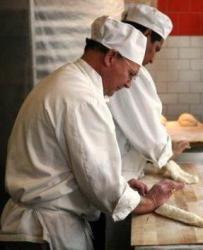
SOUREST sourdough bread
what is the best recipe for the SOUREST sourdough on the planet? Something that smells like old cheddar cheese as an example?

what is the best recipe for the SOUREST sourdough on the planet? Something that smells like old cheddar cheese as an example?

I make round loaves of dark rye bread and bake it on parchment paper sprinkled with cornmeal on a sheet pan. The bottoms of the loaves are coming out too dark and hard. Any suggestions as to how I can prevent this? If I use a baking stone does it have to go into a cold oven and would this prevent the dark bottoms? Any suggestions would be greatly appreciated.

I have started using a predigestion for my WW loaves to compensate for phytic acid, but I seem to be having trouble getting a good rise out of my loaves. My predigestions have been approx 12-14 hours with 3, 45 min rises after adding the additional ingredients. Has anyone else had any problems with this? I am wondering if the 14 hours is great for dealing with phytic acid but perhaps breaks down the gluten too much for average sized WW loaves. Thoughts?


Does anyone have any idea where I could find tempered glass to fit in my small oven door? I have called all over and no glass place carries any and can't reccomend where I could look. Just tried EBAY and no luck there either. The piece I need is only about 9 x 3 inces or so. I also did a google seach and no luck there either, or maybe I don't know the proper way to seach for what I need. Any help is apprecialted, it's for the door in our small pizza oven. Thanks, Mattie

Since I returned from a class on the classic French breads at KAF I've been attempting to reproduce the quality of the bakes we accomplished there. Especially with baguettes where, with a still shaky scoring technique, I nonetheless managed to produce some decent looking grignes while there.

A day or three ago I read a message from someone who asked, very reasonably, why make bread from scratch when it's possible to turn out bread from prepared mixes at lower cost and which rise every time. They're good questions and they're ones we may all have asked at some previous time.

Yeah!! My mixer finally works! HA! Really, I think I'm just the one who works now! Thanks everyone for all the helpful tips for using my DLX. Just making my second batch of sourdough, I dumped everything in with the dough hook and let it rest at first like Eric suggested. Then continued mixing, it worked TOTALLY GREAT!!!!
Thank you for all the helpful tips on everything! I'm going to try that Rosemary Olive loaf next Floyd! That looks awesome!! I'm still trying to get this bakers math stuff down! I love baking! This is so fun!!
Faith